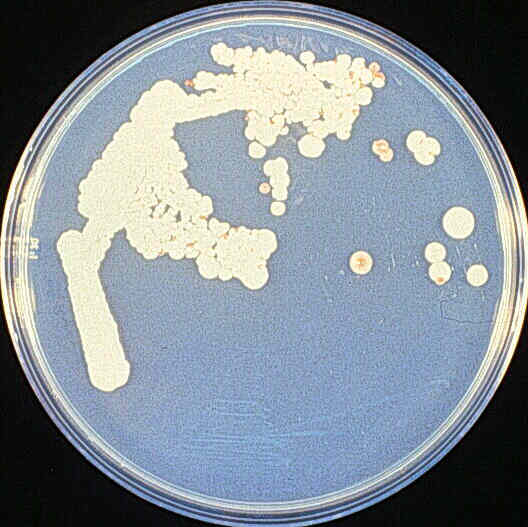 It’s about time I got to the long-promised post about benzoic acid. The thing is, I don’t want to assume everybody reading this is well-versed in chemistry or anything, so after much thought I’m going to split this into three posts. This first one is a bit of chemistry review for some topics that are important to how benzoic acid acts as a preservative. People who are bored by this or know more about it than I do are welcome to either wait for the next post or leave corrections or questions in the comments as you see fit. (Brief note to people reading this from the RSS feed – I’ve noticed that the stylesheet information doesn’t transfer with the RSS, so you won’t see where the web page view would indicate that there is additional information available for some of the terms here. Try hovering over various words and phrases in this post, though, and the information should pop up if it’s there…or just pop in at the main site and post questions if you have any.)
It’s about time I got to the long-promised post about benzoic acid. The thing is, I don’t want to assume everybody reading this is well-versed in chemistry or anything, so after much thought I’m going to split this into three posts. This first one is a bit of chemistry review for some topics that are important to how benzoic acid acts as a preservative. People who are bored by this or know more about it than I do are welcome to either wait for the next post or leave corrections or questions in the comments as you see fit. (Brief note to people reading this from the RSS feed – I’ve noticed that the stylesheet information doesn’t transfer with the RSS, so you won’t see where the web page view would indicate that there is additional information available for some of the terms here. Try hovering over various words and phrases in this post, though, and the information should pop up if it’s there…or just pop in at the main site and post questions if you have any.)
There are several ways people separate types of molecules into opposites. For example, ionic vs. covalent, polar vs. non-polar, or hydrophilic vs. hydrophobic. Although these three categories are each a little different from each other, they all relate to the same thing. As with all other chemistry, it all has to do with what the electrons are doing.
When atoms react with each other, they have a big fight over each other’s electrons. The reaction “finishes” (reaches equilibrium) when this custody battle is concluded. Each of the three categories above relate to how equitable the electron-sharing arrangment ends up being. Once the molecule’s atoms arrange themselves, if the custody of the electrons is distributed fairly evenly around the entire molecule, the molecule is considered “non-polar”. On the other hand, if the atoms at some corner of the molecule end up with more custody of the electrons than the other areas, the molecule ends up having an end that’s slightly more negatively charged (remember electrons are arbitrarily defined as being “negative”) than the others, and the molecule is “polar”. If you dissolve that polar molecule in water and the atoms remain together stubbornly clinging to the shared electrons, the molecule is considered “covalent” (“valence” refers to the area around atoms that electrons “orbit”), whereas if one or more of the atoms readily gains or gives up complete custody of one or more electrons and drifts away from the rest of the molecule, the molecule is considered “ionic”. (It amuses me to think of these latter two terms as “homoelectrical” and “heteroelectrical”. Yes, I am easily amused, why do you ask?) Plain old table salt is what you get when atoms of Sodium (“Na“) and Chlorine (“Cl”) get into one of these electron fights. If you were to look at a Periodic Table of Elements, take a look at the column way over on the left, with Sodium (Na) and Potassium (K) and so on. All of these have one electron that they just don’t really give a crap about. Way over on the other side of the table, one column over from the far right, you’ll see Fluorine (F), Chlorine(Cl) and so on. All of THOSE desperately want an extra electron (Chlorine is the third most electron-greedy – “electronegative” – atom, behind Fluorine and Oxygen). Stick Sodium Chloride in water, and Chlorine says “MINE!”, and Sodium says “Ah, whatever, who needs it?” and the gentle pull of the water molecules around them easily overcome the electric charge based attraction of the now positively charged sodium ion and the now negatively charged chlorine ion, and the two atoms drift apart.
This brings us to “hydrophobic” and “hydrophilic”. There’s a truism in chemistry that “like dissolves like”. Polar substances tend to dissolve well in other polar substances, and non-polar substances tend to dissolve well in other non-polar substances, but polar and non-polar substances don’t mix well at all. Water is a polar substance – it’s got an electron-greedy oxygen atom in between two comparatively electron-apathetic hydrogen atoms. What’s more, the two hydrogen atoms aren’t on exactly opposite sides of the oxygen atom. The “H-O-H” arrangement is actually bent (at just over 104°, if you care), so a water molecule ends up being slightly triangular, with one corner being a little bit negative (where the oxygen atom clings more to the electrons) and two corners with the hydrogens being a little bit positive. Any other molecule with a slightly-positive or slightly-negative part will find that part attracted to one side or the other of water molecules, and as a result will tend to be pulled out into the water as the molecules bounce around [i.e. it will dissolve]. On the opposite end of the scale, molecules with their electrons relatively evenly spread over them tend not to be soluble in water. Large molecules like fats are in this category, which is why fat floats on top of water rather than dissolving in it.
There are two other random facts that I need to wedge in here somewhere. First, the line between “covalent” and “ionic” is actually kind of arbitrary. Water is considered “covalent”, but a very small fraction of the times that two water molecules run into each other, they’ll hit just right so that the slightly-negative oxygen atom on one of them manages to attract one of the slightly-positive hydrogen atoms enough to make it leave an electron behind and jump over. When that happens, you end up briefly with a positively-charged “hydronium” ion (“H3O+“) and a negatively-charged “hydroxide” (OH–) ion. It doesn’t take too long for a “hydronium” to find a “hydroxide” again and rearrange back into two water molecules, but in pure water at “standard temperature and pressure” (defined as 25°C and one atmosphere of pressure) at any time there are about 620,000,000,000,000,000 hydroniums and hydroxides floating around in a liter of water – assuming I didn’t screw up my math there.
And, finally: a classical definition of an “acid” is something that “donates protons” (that is, hydrogen ions). In water, that means a molecule that provides extra available hydrogen atoms that water can pull off to form “hydronium” ions more often that water alone does.
 And now, at last, we reach the subject of the preservative known as “benzoic acid”. If you read the ingredients lists of the food and drink you buy, you’ll probably never actually see “benzoic acid” on the label. Instead, you’ll see “sodium benzoate” or “potassium benzoate”. If you remember, sodium and potassium don’t really care about one of their electrons, so when you dump “sodium benzoate” in water, the sodium goes floating off to play with the water, leaving behind a negatively-charged benzoate ion with its electron. The extra electron hangs out around the part of the benzoate ion where the electron-greedy oxygen atoms are, making the molecule quite polar. Along comes a new “hydronium” ion, carrying a hydrogen that decides it misses its electron after all, and it jumps over to take over partial custody of the electron that the sodium left behind. In short, you’re going from Sodium + Benzoate + Hydronium + Hydroxide to Sodium + Hydroxide +…Benzoic Acid. (Plus a molecule of water, which is traditionally left out of these kinds of equations, which used to be the “hydronium”.) With the hydrogen attached and sharing the electron, benzoic acid no longer has so much of a charge imbalance and is a lot less polar. Being an acid, Benzoic Acid can also give that hydrogen ion back up again to a molecule of water – exactly the reverse of the reaction that formed it.
And now, at last, we reach the subject of the preservative known as “benzoic acid”. If you read the ingredients lists of the food and drink you buy, you’ll probably never actually see “benzoic acid” on the label. Instead, you’ll see “sodium benzoate” or “potassium benzoate”. If you remember, sodium and potassium don’t really care about one of their electrons, so when you dump “sodium benzoate” in water, the sodium goes floating off to play with the water, leaving behind a negatively-charged benzoate ion with its electron. The extra electron hangs out around the part of the benzoate ion where the electron-greedy oxygen atoms are, making the molecule quite polar. Along comes a new “hydronium” ion, carrying a hydrogen that decides it misses its electron after all, and it jumps over to take over partial custody of the electron that the sodium left behind. In short, you’re going from Sodium + Benzoate + Hydronium + Hydroxide to Sodium + Hydroxide +…Benzoic Acid. (Plus a molecule of water, which is traditionally left out of these kinds of equations, which used to be the “hydronium”.) With the hydrogen attached and sharing the electron, benzoic acid no longer has so much of a charge imbalance and is a lot less polar. Being an acid, Benzoic Acid can also give that hydrogen ion back up again to a molecule of water – exactly the reverse of the reaction that formed it.
That’s the punchline to this: in water, a molecule of benzoic acid might at any one time be without it’s hydrogen and therefore charged/polar and hydrophilic, or it might have the attached hydrogen and be uncharged, relatively non-polar, and be comparatively hydrophobic…or “fat-soluble”.
Next post: So what?




 Microbiology is the dominating topic of this particular blog, but I don’t think I’ve ever addressed what I consider to really count as “micro”biology. This isn’t necessarily an obvious topic. My old “Microbiology” book from 8 years ago, plus the textbook from last year’s “Pathogenic Microbiology” class both contained large sections discussing organisms that are visible without a microscope. Heck, the “Pathogenic Microbiology” text even had a whole section on spider and insect bites. And, tapeworms? Since when is “over 30 feet long” considered “micro”? As I like to say: It’s time for Microbiology to grow up and move out of Medicine’s basement.
Microbiology is the dominating topic of this particular blog, but I don’t think I’ve ever addressed what I consider to really count as “micro”biology. This isn’t necessarily an obvious topic. My old “Microbiology” book from 8 years ago, plus the textbook from last year’s “Pathogenic Microbiology” class both contained large sections discussing organisms that are visible without a microscope. Heck, the “Pathogenic Microbiology” text even had a whole section on spider and insect bites. And, tapeworms? Since when is “over 30 feet long” considered “micro”? As I like to say: It’s time for Microbiology to grow up and move out of Medicine’s basement.

 A pair of “barefoot shoes”
A pair of “barefoot shoes” Science is SATAN spelled backwards
Science is SATAN spelled backwards

 +
+  =?????
=?????